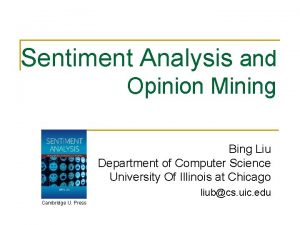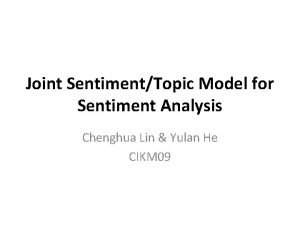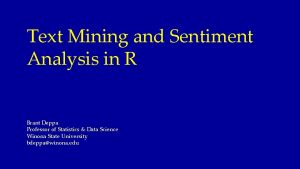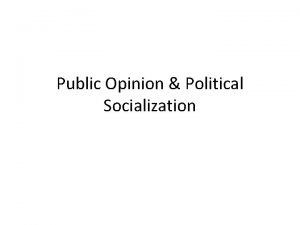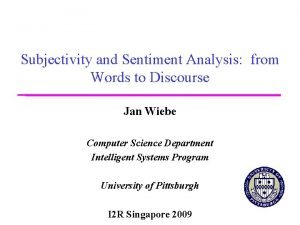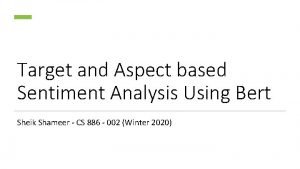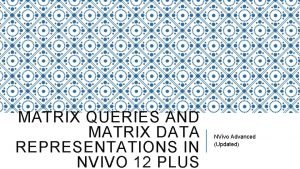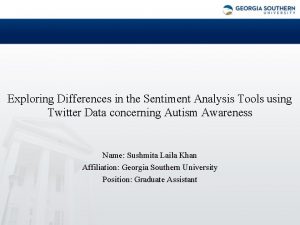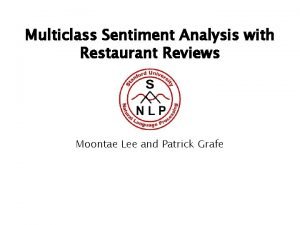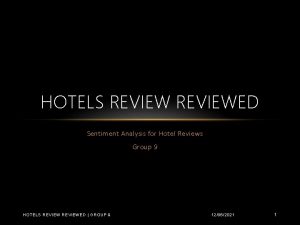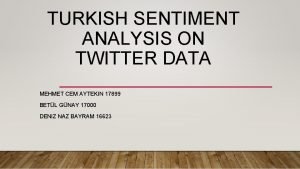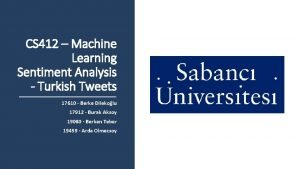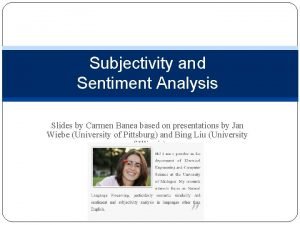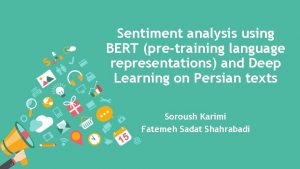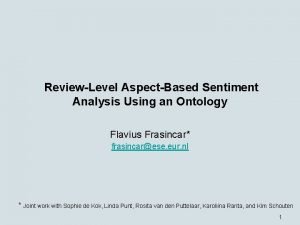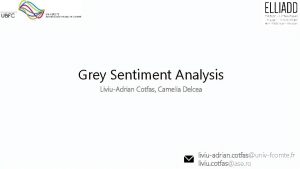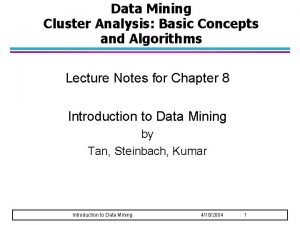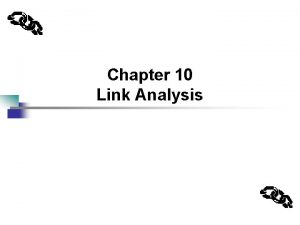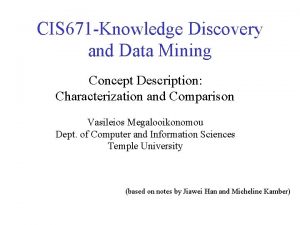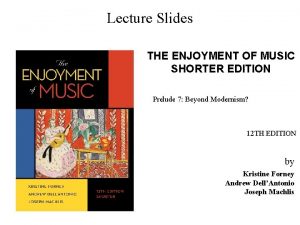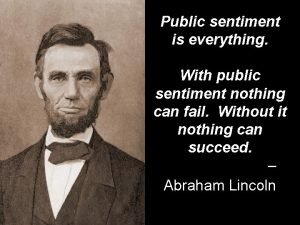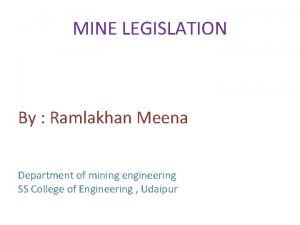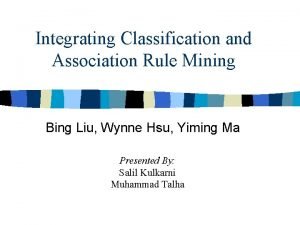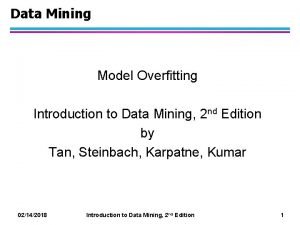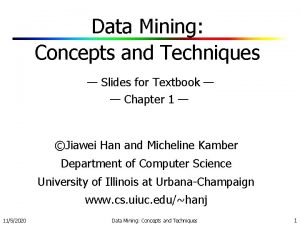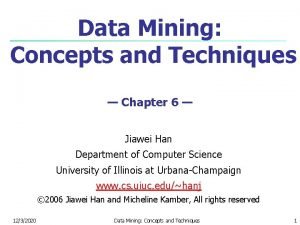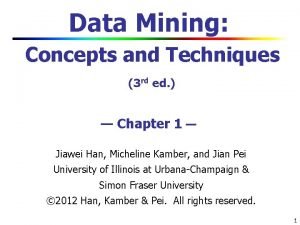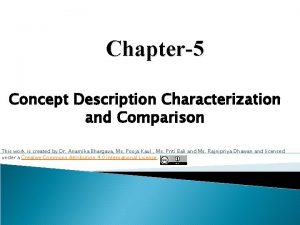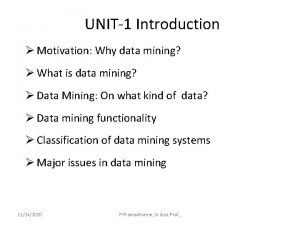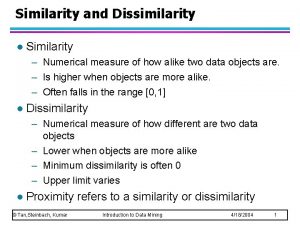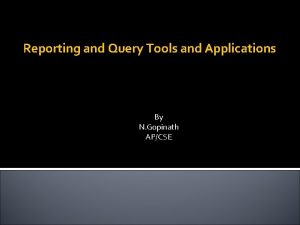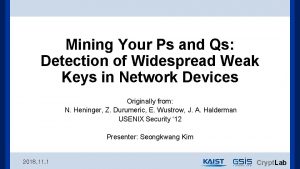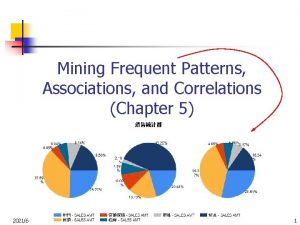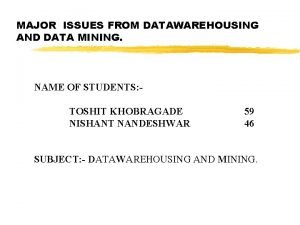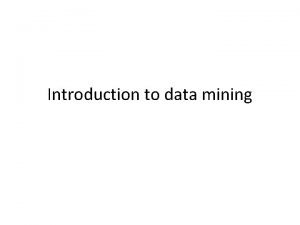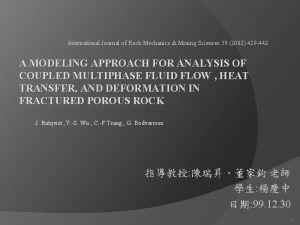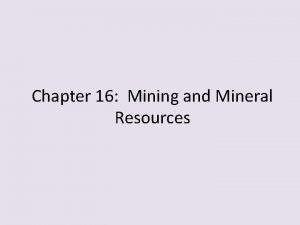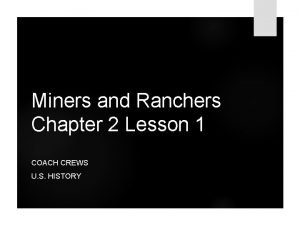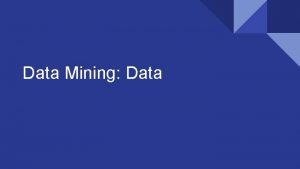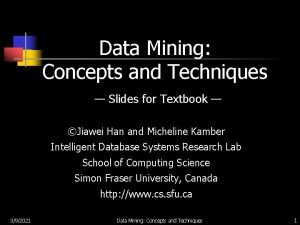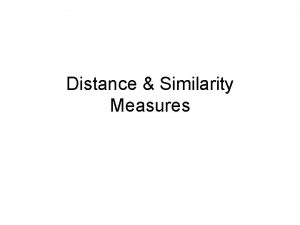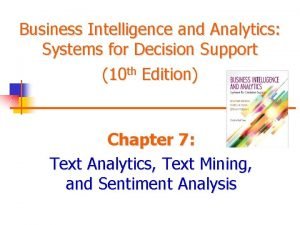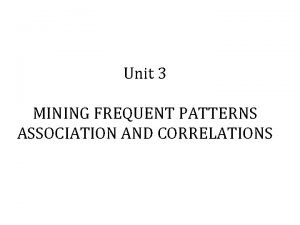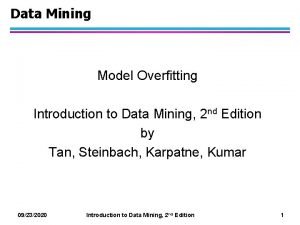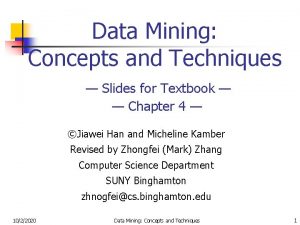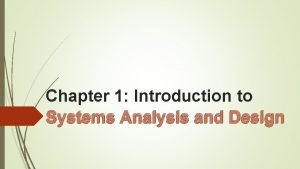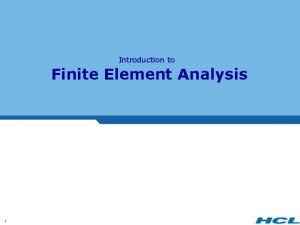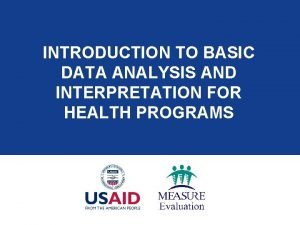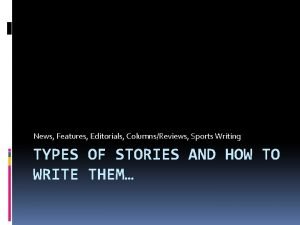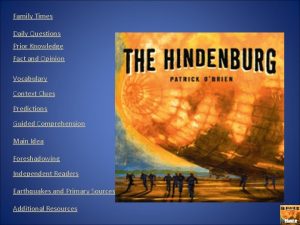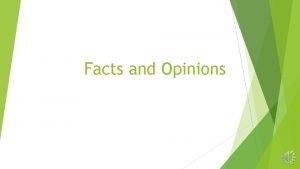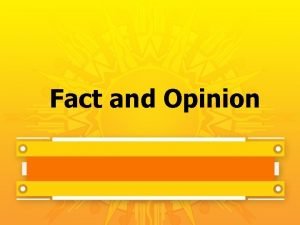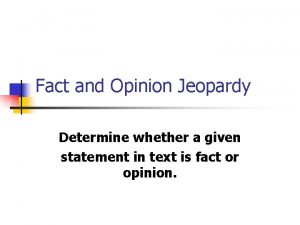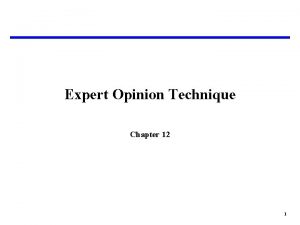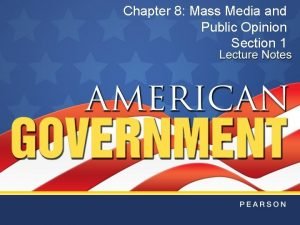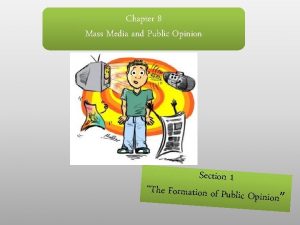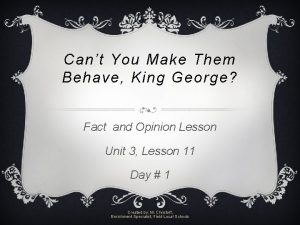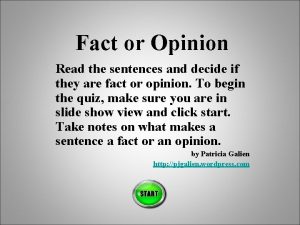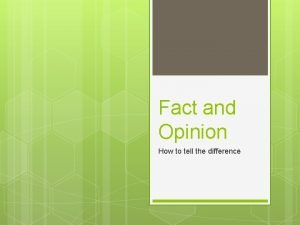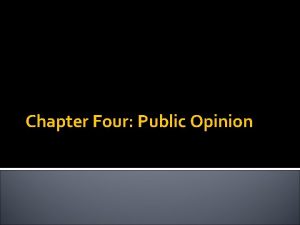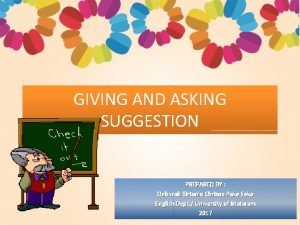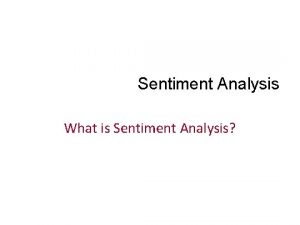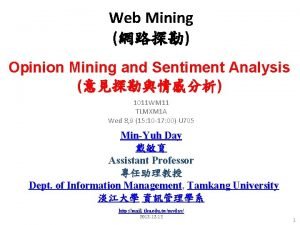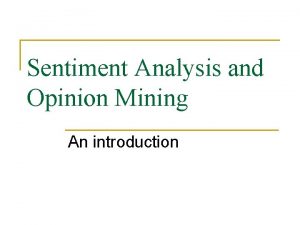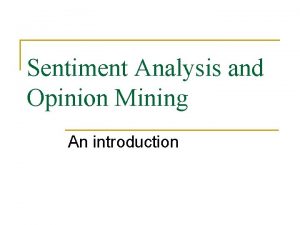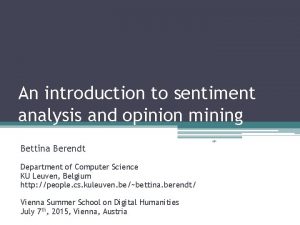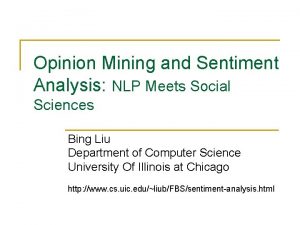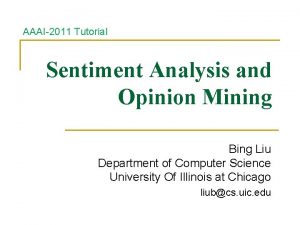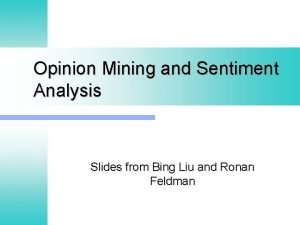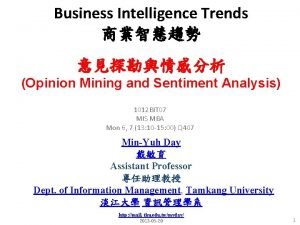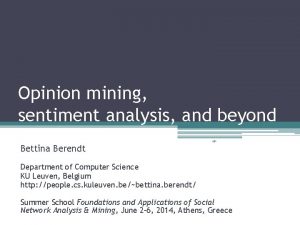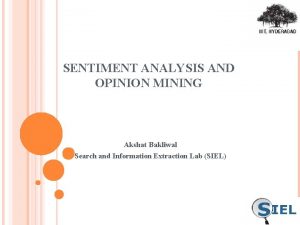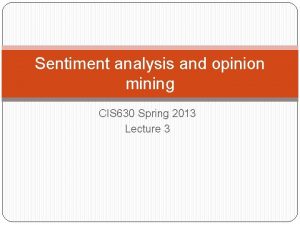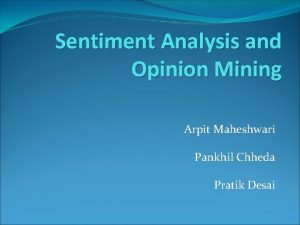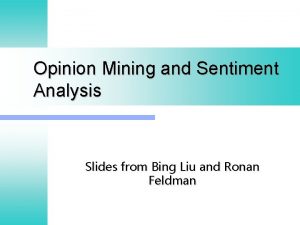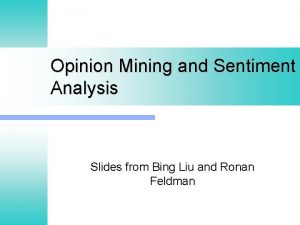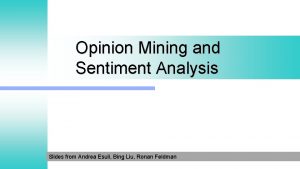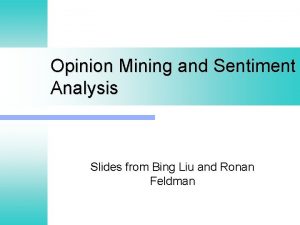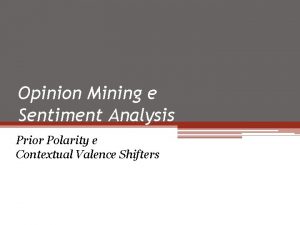Sentiment Analysis and Opinion Mining Introduction n Sentiment




































































































- Slides: 100

Sentiment Analysis and Opinion Mining

Introduction n Sentiment analysis (SA) or opinion mining q n computational study of opinion, sentiment, appraisal, evaluation, and emotion. Why is it important? q Opinions are key influencers of our behaviors. n n q Our beliefs and perceptions of reality are conditioned on how others see the world. Whenever we need to make a decision we often seek out the opinions from others. Rise of social media –> opinion data Rise of AI and chatbots: n Emotion and sentiment are key to human communication 2

Terms defined - Merriam-Webster n Sentiment: an attitude, thought, or judgment prompted by feeling. q q n A sentiment is more of a feeling. “I am concerned about the current state of the economy. ” Opinion: a view, judgment, or appraisal formed in the mind about a particular matter. q q a concrete view of a person about something. “I think the economy is not doing well. ” 3

SA: A fascinating problem! n Intellectually challenging & many applications. q A popular research area in NLP, and data mining (Shanahan, Qu, and Wiebe, 2006 (edited book); Surveys - Pang and Lee 2008; Liu, 2006, 2012, and 2015) q spread from CS to management and social sciences (Hu, Pavlou, Zhang, 2006; Archak, Ghose, Ipeirotis, 2007; Liu Y, et al 2007; Park, Lee, Han, 2007; Dellarocas, Zhang, Awad, 2007; Chen & Xie 2007). q A large number of companies in the space globally n n It touches every aspect of NLP & also is confined. q n > 300 in the US alone. A “simple” semantic analysis problem. A major technology from NLP. q But it is hard. 4

Roadmap n n n n Sentiment analysis problem Document sentiment classification Sentence subjectivity & sentiment classification Aspect-based sentiment analysis Mining comparative opinions Opinion lexicon generation Some interesting sentences Summary 5

Two main types of opinions (Jindal and Liu 2006; Liu, 2010) n Regular opinions: Sentiment/opinion expressions on some target entities q Direct opinions: n q Indirect opinions: n n “After taking the drug, my pain has gone. ” Comparative opinions: Comparison of more than one entity. q n “The touch screen is really cool. ” E. g. , “i. Phone is better than Blackberry. ” We focus on regular opinions first, and just call them opinions. 6

(I): Definition of opinion n Id: Abc 123 on 5 -1 -2008 -- “I bought an i. Phone yesterday. It is such a nice phone. The touch screen is really cool. The voice quality is great too. It is much better than my Blackberry. However, my mom was mad with me as I didn’t tell her before I bought the phone. She thought the phone was too expensive” n Definition: An opinion is a quadruple (Liu, 2012), (target, sentiment, holder, time) n This definition is concise, but not easy to use. q Target can be complex, e. g. , “I bought an i. Phone. The voice quality is amazing. ” n Target = voice quality? (not quite) 7

A more practical definition (Hu and Liu 2004; Liu, 2010, 2012) n An opinion is a quintuple (entity, aspect, sentiment, holder, time) where q q q n entity: target entity (or object). Aspect: aspect (or feature) of the entity. Sentiment: +, -, or neu, a rating, or an emotion. holder: opinion holder. time: time when the opinion was expressed. Aspect-based sentiment analysis 8

Our example blog in quintuples n n Id: Abc 123 on 5 -1 -2008 “I bought an i. Phone a few days ago. It is such a nice phone. The touch screen is really cool. The voice quality is great too. It is much better than my old Blackberry, which was a terrible phone and so difficult to type with its tiny keys. However, my mother was mad with me as I did not tell her before I bought the phone. She also thought the phone was too expensive, …” In quintuples (i. Phone, GENERAL, +, Abc 123, 5 -1 -2008) (i. Phone, touch_screen, +, Abc 123, 5 -1 -2008) …. q We will discuss comparative opinions later. 9

(II): Opinion summary (Hu and Liu 2004) n With a lot of opinions, a summary is necessary. q q n Opinion summary (OS) can be defined precisely, q n not dependent on how summary is generated. Opinion summary needs to be quantitative q n Not traditional text summary: from long to short. Text summarization: defined operationally based on algorithms that perform the task 60% positive is very different from 90% positive. Main form of OS: Aspect-based opinion summary 10

Opinion summary (Hu and Liu, 2004) Aspect/feature Based Summary of opinions about i. Phone: Aspect: Touch screen Positive: 212 n The touch screen was really cool. n The touch screen was so easy to use and can do amazing things. … Negative: 6 n The screen is easily scratched. n I have a lot of difficulty in removing finger marks from the touch screen. … Aspect: voice quality … (Liu et al. 2005) Opinion Summary of 1 phone n + _ Voice Screen Battery size weight n Opinion comparison of 2 phones + _ 11

Aspect-based opinion summary 12

Summarization (Add. Structure. com) n. Great Price (518) n. Good Sound Quality (895) n. Easy Setup (138) n. Great n. Remote n. Speakers (9) n. Inputs (8) n. Little product flaws (8) n. Volume (4) Picture Quality (256) n. Good Sound Quality (77) n. Easy Setup (60) (5) n. Changing Channels (4) n. Volume (3) 13

Not just ONE problem n (entity, aspect, sentiment, holder, time) q q q target entity: aspect of entity: sentiment: opinion holder: time: Named entity extraction, more Aspect extraction Sentiment classification Information/data extraction n There are more problems … n Other NLP problems q q q Synonym grouping (voice = sound quality) Coreference resolution …. . 14

Reason for Opinion/Sentiment n n n Definition: A reason for an opinion is the justification or explanation of the opinion. There are two main cases, e. g. , (1). “I hate this car as it eats too much gas. ” q Negative about an entity due to a bad aspect. n n This can be identified by negative aspects (2). “This car is too small. ” (Shuai et al. 2016) q Negative about an aspect because of a reason n This can be identified by aspect specific sentiment 15

Qualifier of Opinion n n Definition: A qualifier of an opinion limits or modifies the meaning of the opinion. It tells what an opinion is good for, e. g. , q q n “This car is too small for a tall person. ” “The picture quality of night shots is bad” Not every opinion comes with an explicit reason and/or an explicit qualifier. q No reason and no qualifier, e. g. , n “This car is bad. ” 16

Two closely related concepts n n Subjectivity and emotion. Sentence subjectivity q q n An objective sentence presents some factual information, while a subjective sentence expresses some personal feelings, views, emotions, or beliefs. Emotion q A mental state that arises spontaneously rather than through conscious effort and is often accompanied by physiological changes. 17

Subjectivity n Subjective expressions come in many forms, e. g. (Wiebe 2000; Wiebe et al 2004; Riloff et al 2006), q q q n opinions, allegations, desires, beliefs, suspicions, speculations. Many subjective sentences contain no positive or negative opinion q “I think he went home after the class. ” 18

Subjective Opinions n n Definition: A subjective opinion is a regular or comparative opinion given in a subjective statement. For example, q q q “Coke tastes great. ” “I think Google’s profit will go up next month. ” “This camera is a masterpiece. ” “We are seriously concerned about this new policy. ” “Coke tastes better than Pepsi. ” 19

Objective Sentences with Opinion n n Most opinion sentences are subjective, but objective (or factual) sentences can imply opinions too (Liu, 2010). They express desirable or undesirable facts q q q n “The machine stopped working in the second day” “We brought the mattress yesterday, and a body impression has formed. ” “After taking the drug, there is no more pain” Such sentences are very hard to handle 20

Affect, Emotion and Mood n n Three closely related and confusing terms Dictionary definitions: q q Affect. Feeling or emotion, especially as manifested by facial expression or body language. Emotion. A mental state that arises spontaneously rather than through conscious effort and is often accompanied by physiological changes. Mood. A state of mind or emotion. Feeling. An affective state of consciousness, e. g. , resulting from emotions, sentiments, or desires. 21

Definitions from Psychology n n n Affect: a neurophysiological state consciously accessible as the simplest raw feeling. Emotion: the indicator of affect. Owing to cognitive processing, emotion is a compound (not primitive) feeling concerned with an object, such as a person, an event, a thing, or a topic Mood: a feeling or affective state that typically lasts longer than emotion and tends to be more unfocused and diffused 22

Emotion n No agreed set of basic emotions of people. q Based on Parrott (2001), people have six basic emotions, n n love, joy, surprise, anger, sadness, and fear. Although related, emotions and opinions are not equivalent. q Opinion: rational (+/-) view on something n q Cannot say “I like” Emotion: focusing on an inner feeling n Can say “I am angry. ” or “There is sadness in her eyes” 23

24

Cause for Emotion n n Emotions have causes as emotions are usually caused by some internal or external events. “cause” not “reason” because an emotion is an effect produced by a cause (usually an event) rather than a justification or explanation in support of an opinion. q “After hearing of his brother’s death, he burst into tears, ” 25

Definition of Emotion n Definition (Emotion): It is a quintuple, (entity, aspect, emotion_type, feeler, time) q E. g. , “I am so mad with the hotel manager because he refused to refund my booking fee” n n n q Entity: hotel Aspect: manager emotion_type anger feeler: I time: unknown The definition can also include the cause. 26

Emotion Expressions n 1. use emotion or mood words or phrases q n 2. describe emotion-related behaviors, q q n E. g. , love, disgust, angry, and upset “He cried after he saw his mother” and “After he received the news, he jumped up and down for a few minutes like a small boy. ” 3. use intensifiers: Common English intensifiers include q very, so, extremely, dreadfully, really, awfully, etc. 27

Emotion Expressions (conted. ) n 4. use superlatives – q n n many superlative expressions also express emotions, for example, “This car is simply the best” 5. use pejorative (e. g. , “He is a fascist. ”), laudatory (e. g. , “He is a saint. ”), and sarcastic expressions (e. g. , “What a great car, it broke the second day”) 6. use swearing, cursing, insulting, blaming, accusing, and threatening expressions 28

Roadmap n n n n Sentiment analysis problem Document sentiment classification Sentence subjectivity & sentiment classification Aspect-based sentiment analysis Mining comparative opinions Opinion lexicon generation Some interesting sentences Summary 29

Sentiment classification n Classify a whole opinion document (e. g. , a review) based on the overall sentiment of the opinion holder (Pang et al 2002; Turney 2002) q n An example review: q q n Classes: Positive, negative (possibly neutral) “I bought an i. Phone a few days ago. It is such a nice phone, although a little large. The touch screen is cool. The voice quality is great too. I simply love it!” Classification: positive or negative? It is basically a text classification problem 30

Assumption and goal n Assumption: The doc is written by a single person and express opinion/sentiment on a single entity. n Reviews usually satisfy the assumption. q q n Almost all research papers use reviews Positive: 4 or 5 stars, negative: 1 or 2 stars Forum postings and blogs do not q q They may mention and compare multiple entities Many such postings express no sentiments 31

Supervised learning (Pang et al, 2002) n n Directly apply supervised learning techniques to classify reviews into positive and negative. Three classification techniques were tried: q n n Naïve Bayes, Maximum Entropy, Support Vector Machines (SVM) Features: negation tag, unigram (single words), bigram, POS tag, position. SVM did the best based on movie reviews. 32

Features for supervised learning n n The problem has been studied by numerous researchers. Key: feature engineering. A large set of features have been tried by researchers. E. g. , q q q Terms frequency and different IR weighting schemes Part of speech (POS) tags Opinion words and phrases Negations Syntactic dependency 33

Lexicon-based approach (Taboada et al. (2011) n Using a set of sentiment terms, called the sentiment lexicon q q n The SO value for each sentiment term is assigned a value from [− 5, +5]. q n Positive words: great, beautiful, amazing, … Negative words: bad, terrible awful, unreliable, … Consider negation, intensifier (e. g. , very), and diminisher (e. g. , barely) Decide the sentiment of a review by aggregating scores from all sentiment terms 34

Deep learning n Recently, deep neural networks have been used for sentiment classification. E. g. , q q q Socher et al (2013) used deep learning to work on the sentence parse tree based on words/phrases compositionality in the framework of distributional semantics Many papers … Also related n n Irsoy and Cardie (2014) extract opinion expressions Xu, Liu and Zhao (2014) identify opinion & target relations 35

Review rating prediction n Apart from classification of positive or negative sentiments, q q n n research has also been done to predict the rating scores (e. g. , 1– 5 stars) of reviews (Pang and Lee, 2005; Liu and Seneff 2009; Qu, Ifrim and Weikum 2010; Long, Zhang and Zhu, 2010). Training and testing are reviews with star ratings. Formulation: The problem is formulated as regression since the rating scores are ordinal. Again, feature engineering and model building. 36

Roadmap n n n n Sentiment analysis problem Document sentiment classification Sentence subjectivity & sentiment classification Aspect-based sentiment analysis Mining comparative opinions Opinion lexicon generation Some interesting sentences Summary 37

Sentence sentiment analysis n Usually consist of two steps q Subjectivity classification (Wiebe et al 1999) n q Sentiment classification of subjective sentences n n To identify subjective sentences Into two classes, positive and negative But bear in mind q q Many objective sentences can imply sentiments Many subjective sentences do not express positive or negative sentiments/opinions n E. g. , ”I believe he went home yesterday. ” 38

Assumption n n Assumption: Each sentence is written by a single person and expresses a single positive or negative opinion/sentiment. True for simple sentences, e. g. , q n “I like this car” But not true for many compound and “complex” sentences, e. g. , q q “I like the picture quality but battery life sucks. ” “Apple is doing very well in this poor economy. ” 39

Subjectivity and sentiment classification (Yu and Hazivassiloglou, 2003) n Subjective sentence identification: a few methods were tried, e. g. , q q n Sentence similarity. Naïve Bayesian classification. Sentiment classification (positive, negative or neutral) (also called polarity): it uses a similar method to (Turney, 2002), but q q with more seed words (rather than two) and based on loglikelihood ratio (LLR). For classification of each word, it takes the average of LLR scores of words in the sentence and use cutoffs to decide positive, negative or neutral. 40

Segmentation and classification (Wilson et al 2004) n n Since a single sentence may contain multiple opinions and subjective and factual clauses A study of automatic clause sentiment classification was presented in (Wilson et al 2004) q to classify clauses of every sentence by the strength of opinions being expressed in individual clauses, down to four levels n n neutral, low, medium, and high Clause-level may not be sufficient q “Apple is doing very well in this lousy economy. ” 41

Supervised & unsupervised methods n Numerous papers have been published on using supervised machine learning (Pang and Lee 2008; Liu 2015). q q n Again, deep neural networks have been used (Socher et al 2013) working on the sentence parse tree, words/phrases compositionality in the framework of distributional semantics. Many more papers … Lexicon-based methods have been applied too (e. g. , Hu and Liu 2004; Kim and Hovy 2004). 42

Roadmap n n n n Sentiment analysis problem Document sentiment classification Sentence subjectivity & sentiment classification Aspect-based sentiment analysis Mining comparative opinions Opinion lexicon generation Some interesting sentences Summary 43

We need to go further n Sentiment classification at both the document and sentence (or clause) levels are useful, but q n They do not identify the targets of opinions, i. e. , q q n They do not find what people liked and disliked. Entities and their aspects Without knowing targets, opinions are of limited use. We need to go to the entity and aspect level. q q Aspect-based opinion mining and summarization (Hu and Liu 2004). We thus need the full opinion definition. 44

Recall the opinion definition (Hu and Liu 2004; Liu, 2010, 2012) n An opinion is a quintuple (entity, aspect, sentiment, holder, time) where q q q n entity: target entity (or object). Aspect: aspect (or feature) of the entity. Sentiment: +, -, or neu, a rating, or an emotion. holder: opinion holder. time: time when the opinion was expressed. Aspect-based sentiment analysis 45

Aspect extraction n Goal: Given an opinion corpus, extract all aspects n Four main approaches: q q (1) Finding frequent nouns and noun phrases (2) Exploiting opinion and target relations (3) Supervised learning (4) Topic modeling 46

(1) Frequent nouns and noun phrases (Hu and Liu 2004) n n Nouns (NN) that are frequently mentioned are likely to be true aspects (frequent aspects). Why? q q q Most aspects are nouns or noun phrases When product aspects/features are discussed, the words they use often converge. Those frequent ones are usually the main aspects that people are interested in. 47

Using part-of relationship and the Web (Popescu and Etzioni, 2005) n n Improved (Hu and Liu, 2004) by removing some frequent noun phrases that may not be aspects. It identifies part-of relationship q q Each noun phrase is given a pointwise mutual information score between the phrase and part discriminators associated with the product class, e. g. , a scanner class. E. g. , “of scanner”, “scanner has”, etc, which are used to find parts of scanners by searching on the Web: 48

(2) Exploiting opinion & target relation n Key idea: opinions have targets, i. e. , opinion terms are used to modify aspects and entities. q q n n “The pictures are absolutely amazing. ” “This is an amazing software. ” The syntactic relation is approximated with the nearest noun phrases to the opinion word in (Hu and Liu 2004). The idea was generalized to q q syntactic dependency in (Zhuang et al 2006) double propagation in (Qiu et al 2009). A similar idea also in (Wang and Wang 2008) 49

Extract aspects using DP (Qiu et al. 2009; 2011) n Double propagation (DP) q n Use dependency of opinions & aspects to extract both aspects & opinion words. q q n Based on the definition earlier, an opinion should have a target, entity or aspect. Knowing one helps find the other. E. g. , “The rooms are spacious” It extracts both aspects and opinion words. q A domain independent method. 50

The DP method n DP is a bootstrapping method q q n Input: a set of seed opinion words, no aspect seeds needed Based on dependency grammar (Tesniere 1959). q “This phone has good screen” 51

Rules from dependency grammar 52

The DP method again 53

Select the optimal set of rules (Liu et al. , 2015) n Instead of manually deciding a fixed set of dependency rules/relations as in DP, q the paper proposed to select rules automatically. n q q n based on rule induction (Liu, Hsu & Ma 1998) in ML. The input has all dependency relations/rules. The system selects an “optimal” subset. The selected rule subset performs extraction significantly better. q Some rules in DP were actually not selected. 54

Extract opinion, target and relation (Xu, Liuopinion and Zhao, 2014) n An relation q n n has three components: a correct opinion word, a correct opinion target and the linking relation between them. This paper proposed a deep learning approach to identify them. Due to the problem of obtaining negative training data, q q It applied the idea of one-classification. Final network: One-Class Deep Neural Network 55

Explicit and implicit aspects (Hu and Liu, 2004) n Explicit aspects: Aspects explicitly mentioned as nouns or noun phrases in a sentence q n Implicit aspects: Aspects not explicitly mentioned in a sentence but are implied q q q n “The picture quality is of this phone is great. ” “This car is so expensive. ” “This phone will not easily fit in a pocket. ” “Included 16 MB is stingy. ” Some work has been done (Su et al. 2009; Hai et al 2011) 56

(3) Using supervised learning n Using sequence labeling methods such as q q q n Hidden Markov Models (HMM) (Jin and Ho, 2009) Conditional Random Fields (Jakob and Gurevych, 2010). Other supervised or partially supervised learning. (Liu, Hu and Cheng 2005; Kobayashi et al. , 2007; Li et al. , 2010; Choi and Cardie, 2010; Yu et al. , 2011; Fang and Huang, 2012). 57

Identify aspect synonyms (Carenini et al 2005) n Once aspect expressions are discovered, group them into aspect categories. q n E. g. , power usage and battery life are the same. Method: based on some similarity metrics, but it needs a taxonomy of aspects. q q Mapping: The system maps each discovered aspect to an aspect node in the taxonomy. Similarity metrics: string similarity, synonyms and other distances measured using Word. Net. 58

Group aspect synonyms (Zhai et al. 2011 a, b) n Unsupervised learning: q q Clustering: EM-based. Constrained topic modeling: Constrained-LDA n n By intervening Gibbs sampling. A variety of information/similarities are used to cluster aspect expressions into aspect categories. q q q Lexical similarity based on Word. Net Distributional information (surrounding words context) Syntactical constraints (sharing words, in the same sentence) 59

EM method n Word. Net similarity n EM-based probabilistic clustering 60

(4) Topic Modeling n Aspect extraction has two tasks: q q n (1) extract aspect expressions (2) cluster them (same: “picture, ” “photo, ” “image”) Top models such as p. LSA (Hofmann 1999) and LDA (Blei et al 2003) perform both tasks at the same time. A topic is basically an aspect. q q A document is a distribution over topics A topic is a distribution over terms/words, e. g. , n {price, cost, cheap, expensive, …} q Ranked based on probabilities (not shown). 61

Many Related Models and Papers n n n Use topic models to model aspects. Jointly model both aspects and sentiments Knowledge-based modeling: Unsupervised models are often insufficient q q Not producing coherent topics/aspects To tackle the problem, knowledge-based topic models have been proposed n n Guided by user-specified prior domain knowledge. Seed terms or constraints 62

Aspect sentiment classification n n For each aspect, identify the sentiment about it Work based on sentences, but also consider, q q n A sentence can have multiple aspects with different opinions. E. g. , The battery life and picture quality are great (+), but the view founder is small (-). Almost all approaches make use of opinion words and phrases. But notice: q q Some opinion words have context independent orientations, e. g. , “good” and “bad” (almost) Some other words have context dependent orientations, e. g. , “long, ” “quiet, ” and “sucks” (+ve for vacuum cleaner) 63

Aspect sentiment classification “Apple is doing very well in this poor economy” n Lexicon-based approach: Opinion words/phrases q n Parsing: simple sentences, compound sentences, conditional sentences, questions, modality verb tenses, etc (Hu and Liu, 2004; Ding et al. 2008; Narayanan et al. 2009). Supervised learning is tricky: q q Feature weighting: consider distance between word and target entity/aspect (e. g. , Boiy and Moens, 2009) Use a parse tree to generate a set of target dependent features (e. g. , Jiang et al. 2011) 64

A lexicon-based method (Ding et al. 2008) n n n Input: A set of opinion words and phrases. A pair (a, s), where a is an aspect and s is a sentence that contains a. Output: whether the opinion on a in s is +ve, -ve, or neutral. Two steps: q Step 1: split the sentence if needed based on BUT words (but, except that, etc). q Step 2: work on the segment sf containing a. Let the set of opinion words in sf be w 1, . . , wn. Sum up their orientations (1, -1, 0), and assign the orientation to (a, s) based on: where wi. o is the opinion orientation of wi. d(wi, a) is the distance from a to wi. 65

Sentiment shifters (e. g. , Polanyi and Zaenen 2004) n Sentiment/opinion shifters (also called valence shifters are words and phrases that can shift or change opinion orientations. q q Negation words like not, never, cannot, etc. , are the most common type. Many other words and phrases can also alter opinion orientations. E. g. , modal auxiliary verbs (e. g. , would, should, could, etc) n n “The brake could be improved. ” Very complicated, see (Liu 2015) 66

Sentiment shifters (contd) n Some presuppositional items can change opinions too, e. g. , barely and hardly q q n Words like fail, omit, neglect behave similarly, q n “This camera fails to impress me. ” Sarcasm changes orientation too q n “It hardly works. ” (comparing to “it works”) It presupposes that better was expected. “What a great car, it did not start the first day. ” Jia, Yu and Meng (2009) designed some rules based on parsing to find the scope of negation. 67

Basic rules of opinions (Liu, 2010; 2012) n Opinions/sentiments are governed by many rules, e. g. , (many such rules) q Opinion word or phrase: “I love this car” P N q : : = a positive opinion word or phrase an negative opinion word or phrase Desirable or undesirable facts: “After my wife and I slept on it for two weeks, I noticed a mountain in the middle of the mattress” P N : : = desirable fact undesirable fact 68

Basic rules of opinions q High, low, increased and decreased quantity of a positive or negative potential item: “The battery life is long. ” PO : : = | NE : : = | NPI : : = PPI : : = no, low, less or decreased quantity of NPI large, larger, or increased quantity of PPI no, low, less, or decreased quantity of PPI large, larger, or increased quantity of NPI a negative potential item a positive potential item 69

Basic rules of opinions q Decreased and increased quantity of an opinionated item: “This drug reduced my pain significantly. ” PO NE q : : = | less or decreased N more or increased P less or decreased P more or increased N Deviation from the desired value range: “This drug increased my blood pressure to 200. ” PO NE : : = within the desired value range : : = above or below the desired value range 70

Basic rules of opinions q Producing and consuming resources and wastes: “This washer uses a lot of water” PO NE : : = | | | produce a large quantity of or more resource produce no, little or less waste consume no, little or less resource consume a large quantity of or more waste produce no, little or less resource produce some or more waste consume a large quantity of or more resource consume no, little or less waste 71

Roadmap n n n n Sentiment analysis problem Document sentiment classification Sentence subjectivity & sentiment classification Aspect-based sentiment analysis Mining comparative opinions Opinion lexicon generation Some interesting sentences Summary 72

Comparative Opinions (Jindal and Liu, 2006) n Gradable q Non-Equal Gradable: Relations of the type greater or less than n q Equative: Relations of the type equal to n q “The sound of phone A is better than that of phone B” “Camera A and camera B both come in 7 MP” Superlative: Relations of the type greater or less than all others n “Camera A is the cheapest in market” 73

Analyzing Comparative Opinions n Objective: Given an opinionated document d, Extract comparative opinions: (E 1, E 2, A, po, h, t), E 1 and E 2; entity sets being compared A: their shared aspects - the comparison is based on po: preferred entity set h: opinion holder t: time when the comparative opinion is posted. n Note: not positive or negative opinions. 74

An example n Consider the comparative sentence q q n “Canon’s optics is better than those of Sony and Nikon. ” Written by John in 2010. The extracted comparative opinion/relation: q ({Canon}, {Sony, Nikon}, {optics}, preferred: {Canon}, John, 2010) 75

Common comparatives n n In English, comparatives are usually formed by adding -er and superlatives are formed by adding est to their base adjectives and adverbs Adjectives and adverbs with two syllables or more and not ending in y do not form comparatives or superlatives by adding -er or -est. q n Instead, more, most, less, and least are used before such words, e. g. , more beautiful. Irregular comparatives and superlatives, i. e. , more most, less, least, better, best, worse, worst, etc 76

Some techniques (Jindal and Liu, 2006, Ding et al, 2009) n Identify comparative sentences q n Extraction of different items q q n Label sequential rules Conditional random fields (CRF) Determine preferred entities (opinions) q n Supervised learning Lexicon-based methods: Parsing and opinion lexicon (Yang and Ko, 2011) is similar to (Jindal and Liu 2006) 77

Analysis of comparative opinions n Gradable comparative sentences can be dealt with almost as normal opinion sentences. q E. g. , “optics of camera A is better than that of camera B” q q n Positive: (camera A, optics) Negative: (camera B, optics) Difficulty: recognize non-standard comparatives q E. g. , “I am so happy because my new i. Phone is nothing like my old slow ugly Droid. ” 78

Identifying preferred entities (Ganapathibhotla and Liu, 2008) n The following rules can be applied Comparative Negative : : = increasing comparative N | decreasing comparative P Comparative Positive : : = increasing comparative P | decreasing comparative N q E. g. , “Coke tastes better than Pepsi” q “Nokia phone’s battery life is longer than Moto phone” n Context-dependent comparative opinion words q q Using context pair: (aspect, JJ/JJR) Deciding the polarity of (battery_life, longer) in a corpus 79

Roadmap n n n n Sentiment analysis problem Document sentiment classification Sentence subjectivity & sentiment classification Aspect-based sentiment analysis Mining comparative opinions Opinion lexicon generation Some interesting sentences Summary 80

Sentiment (or opinion) lexicon n Sentiment lexicon: lists of words and expressions used to express people’s subjective feelings and sentiments/opinions. q n n Not just individual words, but also phrases and idioms, e. g. , “cost an arm and a leg” They are instrumental for sentiment analysis. There seems to be endless variety of sentiment bearing expressions. q q We have compiled more than 6, 700 individual words. There also a large number of phrases. 81

Sentiment lexicon n Sentiment words or phrases (also called polar words, opinion bearing words, etc). E. g. , q q Positive: beautiful, wonderful, good, amazing, Negative: bad, poor, terrible, cost an arm and a leg. n Many of them are context dependent, not just application domain dependent. n Three main ways to compile such lists: q q q Manual approach: not a bad idea, only an one-time effort Corpus-based approach Dictionary-based approach 82

Corpus-based approaches n Rely on syntactic patterns in large corpora. (Hazivassiloglou and Mc. Keown, 1997; Turney, 2002; Yu and Hazivassiloglou, 2003; Kanayama and Nasukawa, 2006; Ding, Liu and Yu, 2008) q n Can find domain dependent orientations (positive, negative, or neutral). (Turney, 2002) and (Yu and Hazivassiloglou, 2003) are similar. q q Assign opinion orientations (polarities) to words/phrases. (Yu and Hazivassiloglou, 2003) is slightly different from (Turney, 2002) n use more seed words (rather than two) and use loglikelihood ratio (rather than PMI). 83

Corpus-based approaches (contd) n Sentiment consistency: Use conventions on connectives to identify opinion words (Hazivassiloglou and Mc. Keown, 1997). E. g. , q Conjunction: conjoined adjectives usually have the same orientation. n q q E. g. , “This car is beautiful and spacious. ” (conjunction) AND, OR, BUT, EITHER-OR, and NEITHER-NOR have similar constraints. Learning using n n log-linear model: determine if two conjoined adjectives are of the same or different orientations. Clustering: produce two sets of words: positive and negative 84

Context dependent opinion n Find domain opinion words is insufficient. A word may indicate different opinions in same domain. q n “The battery life is long” (+) and “It takes a long time to focus” (-). Ding, Liu and Yu (2008) and Ganapathibhotla and Liu (2008) exploited sentiment consistency (both inter and intra sentence) based on contexts q q q It finds context dependent opinions. Context: (adjective, aspect), e. g. , (long, battery_life) It assigns an opinion orientation to the pair. 85

The Double Propagation method (Qiu et al 2009, 2011) n n The same DP method can also use dependency of opinions & aspects to extract new opinion words. Based on dependency relations q Knowing an aspect can find the opinion word that modifies it n q E. g. , “The rooms are spacious” Knowing some opinion words can find more opinion words n E. g. , “The rooms are spacious and beautiful” 86

Opinions implied by objective terms n n Most opinion words are “subjective words, ” e. g. , good, bad, hate, love, and crap. But objective nouns can imply opinions too. q n Resource usage descriptions may also imply opinions (as mentioned in rules of opinions) q n E. g. , “After sleeping on the mattress for one month, a valley/body impression has formed in the middle. ” E. g. , “This washer uses a lot of water. ” See (Zhang and Liu, 2011 a; 2011 b) for details. 87

Dictionary-based methods n Typically use Word. Net’s synsets and hierarchies to acquire opinion words q q n Start with a small seed set of opinion words. Bootstrap the set by searching for synonyms and antonyms in Word. Net iteratively (Hu and Liu, 2004; Kim and Hovy, 2004; Kamps et al 2004). Use additional information (e. g. , glosses) from Word. Net (Andreevskaia and Bergler, 2006) and learning (Esuti and Sebastiani, 2005). (Dragut et al 2010) uses a set of rules to infer orientations. 88

Semi-supervised learning (Esuti and Sebastiani, 2005) n Use supervised learning q q Given two seed sets: positive set P, negative set N The two seed sets are then expanded using synonym and antonymy relations in an online dictionary to generate the expanded sets P’ and N’. n P’ and N’ form the training sets. Using all the glosses in a dictionary for each term in P’ N’ and converting them to a vector n Build a binary classifier n q Tried various learners. 89

Which approach to use? n n Both corpus and dictionary based approaches are needed. Dictionary usually does not give domain or context dependent meaning q n Corpus-based approach is hard to find a very large set of opinion words q n Corpus is needed for that Dictionary is good for that In practice, corpus, dictionary and manual approaches are all needed. 90

Roadmap n n n n Sentiment analysis problem Document sentiment classification Sentence subjectivity & sentiment classification Aspect-based sentiment analysis Mining comparative opinions Opinion lexicon generation Some interesting sentences Summary 91

Some interesting sentences n n “Trying out Chrome because Firefox keeps crashing. ” q Firefox - negative; no opinion about chrome. q We need to segment the sentence into clauses to decide that “crashing” only applies to Firefox(? ). But how about these q q q “I changed to Audi because BMW is so expensive. ” “I did not buy BWM because of the high price. ” “I am so happy that my i. Phone is nothing like my old ugly Droid. ” 92

Some interesting sentences (contd) n The following two sentences are from reviews in the paint domain. q q n “For paint. X, one coat can cover the wood color. ” “For paint. Y, we need three coats to cover the wood color. We know that paint. X is good and paint. Y is not, but how, by a system. 93

Some interesting sentences (contd) n Conditional sentences are hard to deal with (Narayanan et al. 2009) q q “If I can find a good camera, I will buy it. ” But conditional sentences can have opinions n n “If you are looking for a good phone, buy Nokia” Questions are also hard to handle q q “Are there any great perks for employees? ” “Any idea how to fix this lousy Sony camera? ” 94

Some interesting sentences (contd) n Sarcastic sentences q n Sarcastic sentences are common in political blogs, comments and discussions. q n “What a great car, it stopped working in the second day. ” They make political opinions difficult to handle Some initial work by (Tsur, et al. 2010) 95

Some more interesting sentences n “My goal is to get a tv with good picture quality” n “The top of the picture was brighter than the bottom. ” n “When I first got the airbed a couple of weeks ago it was wonderful as all new things are, however as the weeks progressed I liked it less and less. ” n “Google steals ideas from Bing, Bing steals market shares from Google. ” 96

Opinion mining is hard! n “This past Saturday, I bought a Nokia phone and my girlfriend bought a Motorola phone with Bluetooth. We called each other when we got home. The voice on my phone was not so clear, worse than my previous Samsung phone. The battery life was short too. My girlfriend was quite happy with her phone. I wanted a phone with good sound quality. So my purchase was a real disappointment. I returned the phone yesterday. ” 97

Roadmap n n n n Sentiment analysis problem Document sentiment classification Sentence subjectivity & sentiment classification Aspect-based sentiment analysis Mining comparative opinions Opinion lexicon generation Some interesting sentences Summary 98

Summary n This chapter presented q The problem of sentiment analysis n q n n It provides a structure to the unstructured text. Main research directions and their representative techniques. Still many problems not attempted or studied. None of the subproblems is solved. 99

Summary (contd) n It is a fascinating NLP or text mining problem. q q n Despite the challenges, applications are flourishing! q n Every sub-problem is highly challenging. But it is also restricted (semantically). It is useful to every organization and individual. The general NLU is probably too hard, but can we solve this highly restricted problem? q We have a good chance. 100
 Sentiment analysis and opinion mining bing liu
Sentiment analysis and opinion mining bing liu Joint sentiment topic model for sentiment analysis
Joint sentiment topic model for sentiment analysis Text mining and sentiment analysis in r
Text mining and sentiment analysis in r Difference between strip mining and open pit mining
Difference between strip mining and open pit mining Text and web mining
Text and web mining Strip mining vs open pit mining
Strip mining vs open pit mining Strip mining vs open pit mining
Strip mining vs open pit mining Mining multimedia databases
Mining multimedia databases Mining complex data types
Mining complex data types Pyspark sentiment analysis
Pyspark sentiment analysis Private opinion becomes public opinion when
Private opinion becomes public opinion when Subjectivity in sentiment analysis
Subjectivity in sentiment analysis Sentihood
Sentihood What is nvivo used for
What is nvivo used for Sentiment analysis tools comparison
Sentiment analysis tools comparison Moontae lee
Moontae lee Sentiment analysis for hotel reviews
Sentiment analysis for hotel reviews Turkish sentiment analysis
Turkish sentiment analysis Turkish sentiment analysis
Turkish sentiment analysis Azure twitter sentiment analysis
Azure twitter sentiment analysis Carmen banea
Carmen banea ü
ü Sentiment analysis conclusion
Sentiment analysis conclusion Github liviu cotfas
Github liviu cotfas Introduction to data mining and knowledge discovery
Introduction to data mining and knowledge discovery Azure data mining
Azure data mining Introduction to data warehouse
Introduction to data warehouse Multidimensional analysis and descriptive mining of complex
Multidimensional analysis and descriptive mining of complex Cluster analysis and data mining
Cluster analysis and data mining Complex data types in data mining
Complex data types in data mining Computer games teach us nothing
Computer games teach us nothing Dronix technologies
Dronix technologies Link analysis data mining
Link analysis data mining Relevance analysis in data mining
Relevance analysis in data mining Twitter sentiment
Twitter sentiment Chapter 64. less is more: reich and minimalist music
Chapter 64. less is more: reich and minimalist music Public sentiment is everything
Public sentiment is everything Abolitionist sentiment grows
Abolitionist sentiment grows Solution mining pros and cons
Solution mining pros and cons Fishing and mining
Fishing and mining Mining mate duties and responsibilities
Mining mate duties and responsibilities International journal of rock mechanics and mining sciences
International journal of rock mechanics and mining sciences Integrating classification and association rule mining
Integrating classification and association rule mining What is data mining and data warehousing
What is data mining and data warehousing Overfitting and pruning in data mining
Overfitting and pruning in data mining Data mining confluence of multiple disciplines
Data mining confluence of multiple disciplines Underfitting and overfitting in data mining
Underfitting and overfitting in data mining Function of data mining
Function of data mining Characterization and comparison in data mining
Characterization and comparison in data mining Data mining primitives languages and system architecture
Data mining primitives languages and system architecture Britain diamond mining and increasing labour control
Britain diamond mining and increasing labour control Motivation and importance of data mining
Motivation and importance of data mining Similarity and dissimilarity in data mining
Similarity and dissimilarity in data mining Reporting and query tools in data mining
Reporting and query tools in data mining Advantages of phytomining
Advantages of phytomining Mining your ps and qs
Mining your ps and qs Mining your ps and qs
Mining your ps and qs Associations and correlations in data mining
Associations and correlations in data mining Mining methodology and user interaction issues
Mining methodology and user interaction issues Machine learning and data mining
Machine learning and data mining International journal of rock mechanics and mining sciences
International journal of rock mechanics and mining sciences Classification and clustering in data mining
Classification and clustering in data mining Crm data warehouse models
Crm data warehouse models Eclat algorithm
Eclat algorithm Mineral exploration and mining active reading
Mineral exploration and mining active reading Olap
Olap Data mining slides
Data mining slides Lesson 1 summary miners and ranchers
Lesson 1 summary miners and ranchers Collection of data objects
Collection of data objects Data mining concepts and techniques slides
Data mining concepts and techniques slides Minnesota mining and manufacturing post-it
Minnesota mining and manufacturing post-it Text analytics and text mining
Text analytics and text mining Wziu hub
Wziu hub Smc vs jaccard
Smc vs jaccard Text analytics and text mining
Text analytics and text mining Mining frequent patterns associations and correlations
Mining frequent patterns associations and correlations Overfitting in data mining
Overfitting in data mining Data mining languages and system architecture
Data mining languages and system architecture Introduction to system analysis and design
Introduction to system analysis and design Introduction to system analysis and design
Introduction to system analysis and design Design and analysis of algorithms introduction
Design and analysis of algorithms introduction Fem applications
Fem applications C programming and numerical analysis an introduction
C programming and numerical analysis an introduction Introduction to the design and analysis of algorithms
Introduction to the design and analysis of algorithms Introduction of data analysis and interpretation
Introduction of data analysis and interpretation Sports writing
Sports writing Opinion about family
Opinion about family Fact and opinion about pizza
Fact and opinion about pizza Signal words for fact and opinion
Signal words for fact and opinion Fact and opinion jeopardy
Fact and opinion jeopardy Disadvantages of expert opinion
Disadvantages of expert opinion Chapter 8 mass media and public opinion worksheet answers
Chapter 8 mass media and public opinion worksheet answers Chapter 8 mass media and public opinion worksheet answers
Chapter 8 mass media and public opinion worksheet answers Can you make them behave king george fact and opinion
Can you make them behave king george fact and opinion Argument and opinion
Argument and opinion Read the sentences and decide if they are
Read the sentences and decide if they are The family guy is not appropriate to watch during school
The family guy is not appropriate to watch during school Public opinion in pr
Public opinion in pr Slidetodoc
Slidetodoc Thanksgiving facts
Thanksgiving facts Dialog asking and giving suggestion
Dialog asking and giving suggestion
